What to feed Scottish cats with?
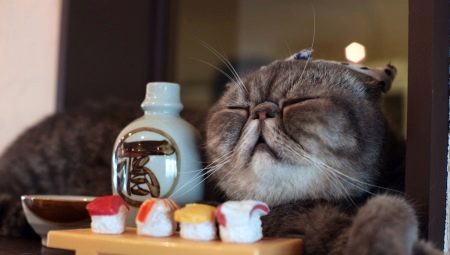
There is an opinion among breeders that the Fold Scottish cat needs to be fed with special food, unlike its straight-eared relative, otherwise its ears will stand up.

But this is not the case - representatives of both species require the same feeding ration. At the same time, the list of recommended products differs from that which is suitable for representatives of other breeds.
Nutritional features of little kittens
Until the kitten reaches the age of 1 month, the mother feeds him, usually the first 2 weeks the number of feedings reaches 10 times a day, and by the month there are already 8 of them, including at night.
After a month, it is already possible to start introducing complementary foods, but nevertheless, mother's milk should remain the main element of the Scottish kitten's diet up to 2.5-3 months, weaning the baby from the breast until this moment is not only undesirable, but also extremely dangerous for the kitten.
If, for some reason, the mother is not there, or she cannot feed the cubs, then the owner should take care of the newborn.
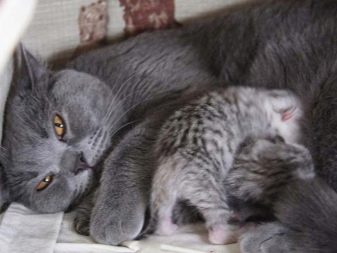
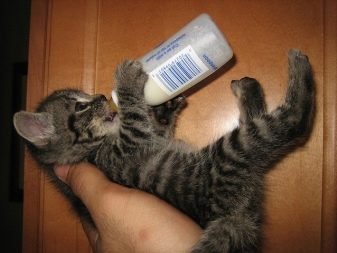
In the first 2 weeks, feeding should be carried out every 2 hours at the rate of 30 ml per 100 g of the baby's body weight, from 2 to 4 weeks the feeding volume should already be 50 ml per 100 g of body weight and after a month - about 55 g.
For nutrition, special mixtures are used, they can be purchased at any veterinary pharmacy, they have a balanced composition, enriched with vitamins, minerals, omega acids and taurine.
The product is introduced using a syringe or a special pipette. The mixture is poured very carefully so that the baby does not choke. Cow's milk is not suitable for kittens.The fact is that cat's milk is 70% water, it contains 11% proteins and 3% lactose, the fat content does not exceed 11% ..
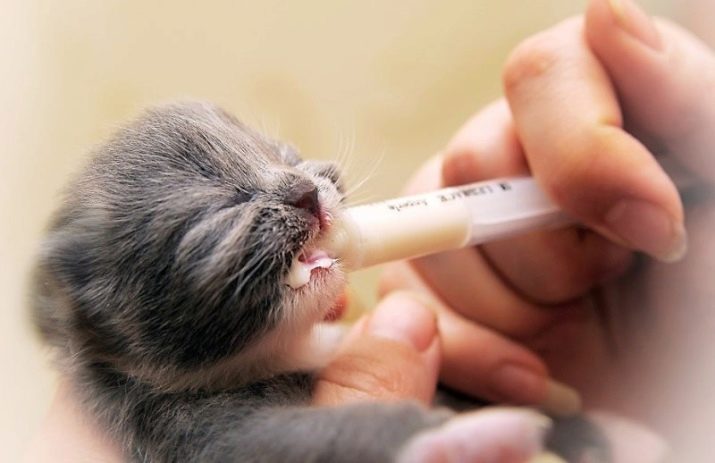
Cow's milk contains about 89% water, 3.2% protein, 3.2% fat and 5.3% lactose. With all the similarity of the composition, the volume of proteins in cow's milk is much lower, but the amount of lactose, on the contrary, is much higher than the proportion of the component in feline. And any veterinarian will confirm that a large amount of lactose in a small kitten's body is absorbed with great difficulty.
If you do not have the opportunity to purchase a special mixture, then it is better to mix cream with egg yolk at the rate of 1 yolk per 200 ml of liquid.
A month-old kitten begins to introduce solid food into the diet. However, the concept of "solid" in this case is relative. At first, it is crushed and diluted to a mushy state, and the more liquid the mash is, the better for a young Scotsman.
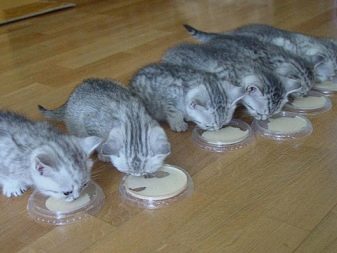
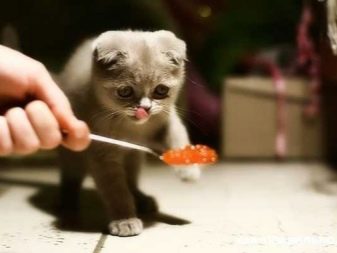
Sometimes breeders are forced to introduce complementary foods up to 1 month - this happens if the cat is emaciated, and she has very little milk - then the kittens begin to squeak often, trying to suck on the cat's chest and fingers of their owners.
Start feeding from one type of food, and only after the kitten has mastered it, they offer the next one. It is best if fermented milk products - for example, low-fat cottage cheese or fermented baked milk - are used as the first food additive.
After the body gets used to these foods, you can gradually introduce the meat. Just do not forget to grind it in a blender or rotate it in a meat grinder.
At 2 months, the Scotsman's body is already ready for weaning, but not for a sharp one - the transfer to solid food should come slowly, which is why breeders rarely sell kittens under three months. At this time, the kitten eats about 6 times a day, and the total amount of food consumed is about 180 g per day.
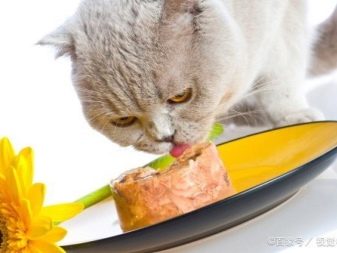

By the end of the second month, you can offer your pet small pieces of meat - by this time, his teeth are already formed. It will be better if you mix the meat with grated vegetables or soaked bran.
Keep in mind that immediately after the final weaning, the kitten needs to get all the vaccinations, as the maternal antibodies cease to support its immunity.
At 2 months he is given vaccinations against distemper and rhinotracheitis, and at 3 months he is given a revaccination.
At 3-4 months, the kitten begins to actively grow, and its gastrointestinal tract is finally formed. During this period, it will be useful to introduce into the diet vitamin-mineral complexes, which necessarily contain calcium.
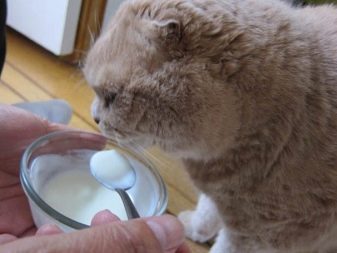
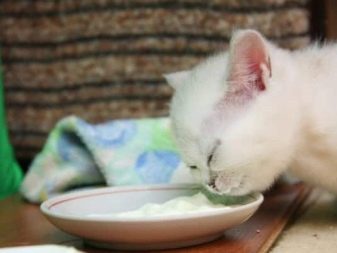
From 4.5 months, the kitten is already considered a teenager, continues to grow, therefore, he needs food rich in proteins. Meat meets his protein needs best. At the same time, there is no longer a need to grind the product, it can be served in medium-sized slices, the animal at this stage of its life must certainly train its jaws.
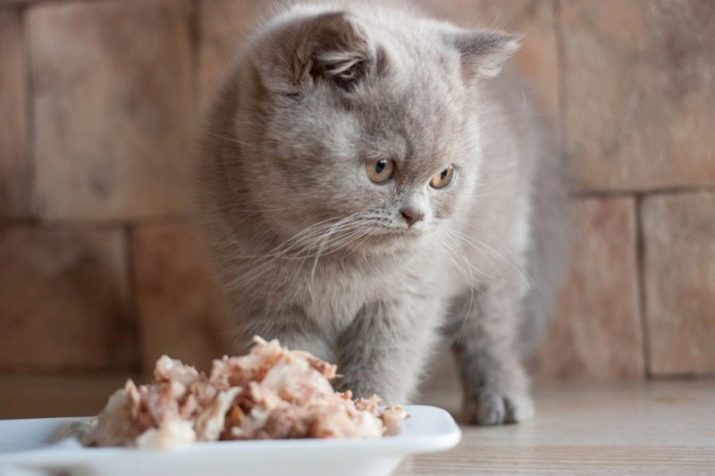
From 5 months, you can introduce lean fish into the diet, it is advisable to take sea fish - this product is offered to cats exclusively in boiled form and no more than once a week.
From 9 months, the kitten is already considered an adult, although the Scots are formed up to two years, nevertheless, the animal's need for proteins and calories is already the same as for older pets - 2-3 feedings per day are enough for him, the total amount of food is usually 180 -200 g.
The kitten's nutrition must be balanced, otherwise he will not avoid problems with stool, vomiting and even abnormal development.
The Little Scotsman must have his own bowls and constant access to water. The water should be changed daily and the drinker kept perfectly clean. By the way, cats are very fond of running water, so they like all kinds of "fountains".


For many years now, breeders around the world have been arguing about what is more useful for a small pet - natural or factory feed.An unequivocal answer to this question cannot be given, since much depends on the owner's ability to draw up a balanced menu for his pet at home, because nothing has been invented better than natural nutrition.
But if you do not have the necessary time, then it is better to stay on feeds that contain all the necessary micro- and macroelements, but keep in mind that preference should be given to the compositions of the premium and super-premium classes, always marked “for kittens”.
Further diet
When a kitten reaches one year of age, the breeder is no longer faced with the task of fattening it, but the pet still needs proteins as the main building material for organs and tissues, carbohydrates as a source of energy, fats, vitamins and minerals.

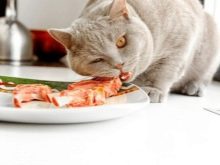
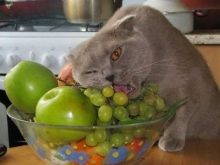
Natural products
Natural feeding is very beneficial for the cat, but the ration should be prepared correctly. About 80% of the menu should be protein foods - meat products and fish.
- Meat. Usually the Scots are given beef, veal, rabbit and chicken. The product must be low-fat and fresh, it can be served boiled or raw. In the latter case, it must be pre-frozen for several days in order to exclude infection with helminths.
- From offal it is recommended to include in the kitten's diet the liver, which contains vitamins useful for hair and bones, as well as the heart - it contains taurine, which has a beneficial effect on the state of the digestive system and organs of vision.
- Fish give once every 7-10 days, it is best to stay on hake or cod, it is strictly forbidden to give the product raw - only boiled or in the form of fish soup, do not forget to separate the meat from the bones.
- Cottage cheese... Non-acidic and low-fat varieties of the product are suitable for the Scotsman's nutrition. Curd is a rich source of potassium, which is required for maintaining healthy bones. In addition, it contains proteins, which are the universal building blocks of the body.
- Cheese. Scots can be offered unsalted and mild cheeses from time to time. The product is rich in protein and calcium, which are good for your pet's health.
- Sour milk. Other lactic acid products recommended for inclusion in the cat's diet include whey or fermented baked milk. But feeding a representative of the cat family with milk is not recommended. The fact is that after two months, the enzyme responsible for the assimilation of this product ceases to be synthesized in the kitten's body, which is why milk in the body of an adult cat is not processed, but creates only an additional load on the organs of the digestive system. Milk is allowed only to small kittens and cats immediately after childbirth.
- Eggs. Cats can be fed the yolk of a chicken egg once a week. The product contains vitamins, it is rich in amino acids and minerals, but you should not give your pet proteins - they contain substances that interfere with the absorption of taurine. If you feed your animal with quail eggs, then you can use whites and yolks, preferably raw.
- Although cats are carnivores, they need vitamins, and vegetables are the best source of them.... Chopped carrots, zucchini, broccoli, cauliflower and beets should certainly be included in the cat's daily menu. In addition, vegetables are rich in fiber - it prevents constipation in the animal.
- Porridge is useful not only for children, but also for animals, therefore, they must be present in the animal's diet.... Oats, barley, buckwheat and rice are good for the Scots. Thanks to the inclusion of cereals in the nutritional system, a more effective liquefaction of feces occurs, peristalsis improves and digestion is generally normalized. In addition, cereals are a good source of energy for an adult animal, so they are offered to a pet at least 3-4 times a week, always boiled without salt and oil.It is advisable to mix cereals with meat and vegetables.
- Greens. It will not be superfluous to introduce chopped dill, parsley, as well as sprouted grains of millet and oats into the Scottish diet - these products are rich in vitamins and have the most beneficial effect on the health of the Scottish cat.
- Butter... In small quantities, the cat's menu includes unrefined oil of flax, sunflower, grape and sea buckthorn. It is given in limited quantities - no more than one spoonful a couple of times a week.
Ready feed
Prepared cat foods are usually canned food, jelly chunks, and dry pads. As a rule, they contain the same products as with natural feeding, only specially processed so that they are stored longer.
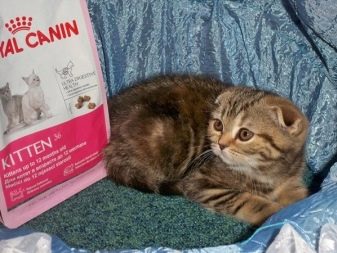
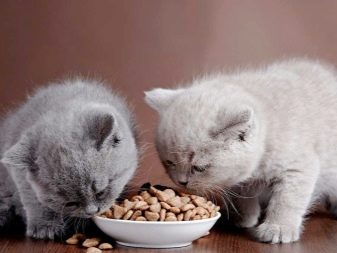
Keep in mind that not every food is equally good for your pet.
When choosing, you should give preference to reliable manufacturers such as Royal Canin, Pro Plan or Happy Cat - they contain natural products in an optimal ratio, enriched with all the necessary vitamins and minerals.
The highly publicized Whiskas, Kitekat, Sheba or Friskies are cheap and sold in any store. However, the percentage of meat in them does not always correspond to the recommended ones, and the composition itself does not differ in "transparency".
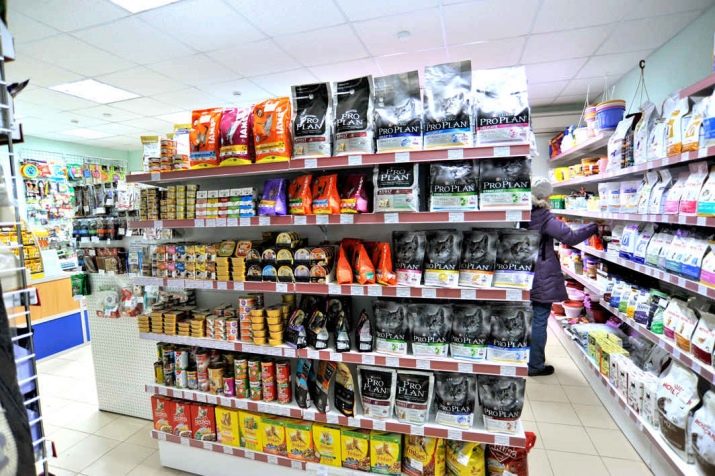
As a consequence, the consumption of mass-market feed by Scots is often the cause of serious health problems for pets.
Mixed type
Mixed nutrition involves the inclusion of both natural products and ready-made store foods in the diet. Immediately, we note that in this case it is better to combine natural food with wet food, dry food requires more water consumption, and it is more difficult for cats to "switch".
When choosing a mixed type of food, veterinarians recommend giving the cat meat, fish and offal, and all other components of the menu can be safely replaced with ready-made food, especially since they are usually fortified with vitamins and minerals.
The ready-made food also contains all the useful amino acids and probiotics that contribute to better digestion of pets and serve as the prevention of many dangerous diseases of cats and cats.
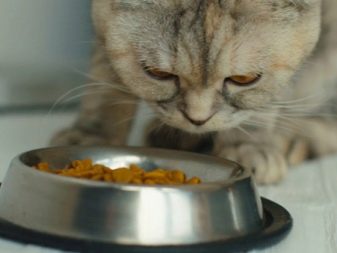

Keep in mind that combining both types of food in the same feed is not a good idea. It will be optimal if in one meal you offer the animal a natural, and in the next - a ready-made composition. Thus, all useful micro- and macroelements will enter the Scotsman's body gradually.
Feeding spayed and neutered animals
The nutrition of neutered cats and neutered cats has its own specifics. So, for the first time 12 hours, the cat moves away from anesthesia - at this moment there is no need to offer food, as soon as the animal begins to feel better, it should be watered through a syringe, making sure that the pet does not choke.
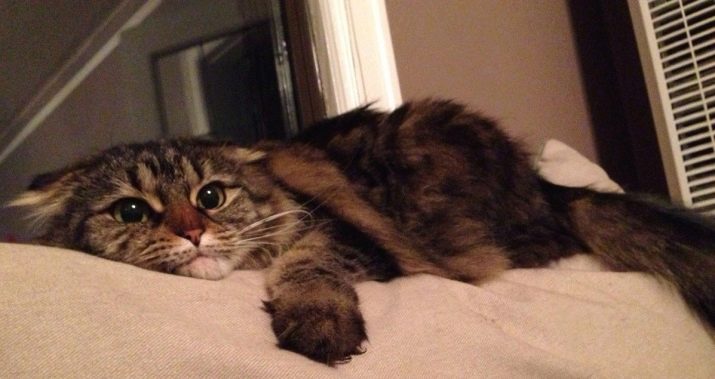
Usually, on the first day, the Scots refuse to eat, you should not force them to eat by force. On the second day, the animal is offered about a third of the usual portion, this is important so that the animal does not strain during bowel movements.
After 3 days the appetite returns to the Scots, and they begin to show interest in food - from this moment you can begin to gradually increase the amount of food, bringing it to 150 g per day.
Keep in mind that spayed and neutered cats are often prone to obesity.
From time to time, arrange your furry for a check: once a month, run your hands along its sides - if you feel the ribs, then you have nothing to worry about, and if the cat has gained too much weight, then temporarily it is worth excluding cereals from its diet, focusing on meat, vegetable and fish products.
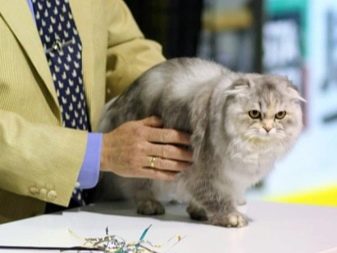
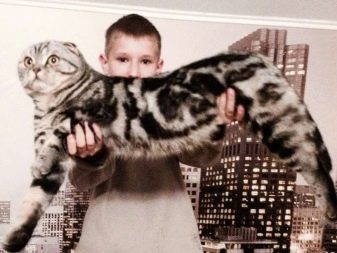

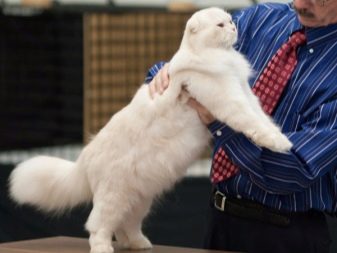
If you feed your pet with ready-made mixtures, then it is worth purchasing specialized formulations "for castrated and neutered animals."
What shouldn't be given?
In conclusion, let's talk about what products do not belong on the Scottish cat menu.
- Sweet. Sweets, pastries, cakes and chocolate are strictly prohibited - they lead to the development of diabetes in the animal.
- Salty... Canned pickles are becoming a common cause of kidney disease, including urolithiasis, which Scots are already prone to by nature.
- Sharp. Spice dishes can cause digestive upset in adult cats and can lead to serious illness in kittens.
- Bold. Allowed in minimal quantities and for adult cats only. This applies to both sour cream and pork - with the abuse of these products, the pet's pancreas simply cannot withstand the load.
- Canned food... Any canned food contains a large amount of salt, vinegar, all kinds of synthetic additives that are harmful to your pet's kidneys.
- Citrus. They are able to permanently disable the organs of smell of the Scottish cat.
- Fruits. Unlike some other cat breeds, Scots cannot digest fruits, so overusing them causes digestive problems.
- Mushrooms and legumes. Considered too heavy a food for animals.
For information on how to make the first complementary food for monthly kittens, see the next video.
































